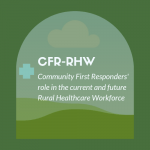| PROJECT TITLE |  COMMUNITY FIRST RESPONDERS’ ROLE IN THE CURRENT AND FUTURE RURAL HEALTH AND CARE WORKFORCE (CFR-RHW) COMMUNITY FIRST RESPONDERS’ ROLE IN THE CURRENT AND FUTURE RURAL HEALTH AND CARE WORKFORCE (CFR-RHW) |
| Funding body | National Institute for Health Research Health Services and Delivery Research Programme and Lincoln Policy Hub |
| Total funding | £481,000 |
| Team |
|
| Lived experience panel |
|
| Team/consortium |
|
| Oversight committee |
|
| Overarching aim | The overarching aim is to work with PPI and stakeholders throughout to develop recommendations for future innovations in rural CFR provision by investigating current activity, costs of provision, and views of patients, public, CFR schemes and rural care providers. |
| Objectives | The objectives of this study are to:
i. Describe the contribution of CFRs to rural health provision in terms of numbers/timing of calls attended, types of conditions and people attended. ii. Evaluate the costs, funding sources, and consequences of CFR schemes. iiia. Explore ambulance/CFR protocols and guidelines. iiib. Explore stakeholder (patients, relatives, ambulance staff, primary care, commissioners, CFRs and CFR scheme organisers) experiences and perceptions of CFRs’ current role and potential for future developments and innovations. We will also ask CFRs and CFR scheme organisers about challenges and solutions to recruiting, training, retaining CFRs in rural areas and how to ensure governance and accountability for safe, high quality care. iv. Assimilate and integrate data from WP1-3 synthesising these using the ABC (actor, behavioural change, causal pathway) theory to develop a list of recommendations for future innovations. v. Prioritise recommendations for future developments/innovations in rural CFR provision through consensus stakeholder workshop. |
| Methods | We used mixed methods, underpinned by a robust theory, the ABC framework, and five linked work packages |
| Outcomes | We will provide feedback tailored to each participating ambulance service and CFR schemes in that region as well as a report of findings to the funder, peer reviewed research articles, conference presentations, together with blogs, infographics and social media to publicise the findings to lay and professional audiences including CFR scheme leads, ambulance leads, commissioners, academics, policy experts with an interest in this area and the public.. |
| Outputs | Publications
Siriwardena AN, Patel G, Botan V, Smith MD, Phung VH, Pattinson J, Trueman I, Ridyard C, Hosseini SMP, Asghar Z, Orner R, Brewster A, Mountain P, Rowan E, Spaight R. Community First Responders’ role in the current and future rural health and care workforce: a mixed methods study. Health and Social Care Delivery Research (in press). Botan V, Asghar Z, Rowan E, Smith M, Patel G, Phung V, Trueman I, Spaight R, Brewster A, Mountain P, Orner R, Siriwardena AN (2023). Community First Responders’ contribution to Emergency Medical Service provision in the UK. Annals of Emergency Medicine 2023: 81(2): 176-183. Patel G, Phung VH, Trueman I, Ørner R, Siriwardena AN (2023). Common hierarchies, varied rules – The problem of governing community first responders in prehospital care for quality standards: documentary discourse analysis. BMC Health Services Research 23: 38. Patel G, Phung V, Trueman I, Pattinson J, Botan V, Hosseini SMP, Ørner R, Asghar Z, Smith MD, Rowan R, Spaight R, Evans J, Brewster A, Mountain P, Siriwardena AN (2023). “It’s like a swan, all nice and serene on top, and paddling like hell underneath”; Community First Responders’ practices in attending patients and contributions to rapid emergency response in rural England, United Kingdom: a qualitative interview study. Scandinavian Journal of Trauma, Resuscitation and Emergency Medicine 31:7.. Orsi A, Watson A, Wijegoonewardene N, Botan V, Lloyd D, Dunbar N, Asghar Z, Siriwardena AN (2022). Perceptions and experiences of Medical Student First Responders: a mixed methods study. BMC Medical Education 22:721. Siriwardena AN et al. Community First Responders’ role in the current and future rural health and care workforce. Protocol Version 2.0. Presentations Patel G, Botan V, Phung VH, Trueman I, Pattinson J, Hosseini SMP, Ørner R, Asghar Z, Smith MD, Rowan E, Spaight R, Evans J, Brewster A, Mountain P, Mortimer C, Miller J, Brown M, Siriwardena AN. PP44 Consensus on innovations and future change agenda in community first responder schemes in England: a national Nominal Group Technique study. Emergency Medicine Journal 2023;40: A18. Phung VH, Patel G, Pattinson J, Trueman I, Siriwardena AN. PP13 Community first responders – their identity and relationship with patients and the ambulance service: a qualitative interview study. Emergency Medicine Journal 2023;40: A6. Hosseini SMP, Smith MD, Patel G, Smith BET, Siriwardena AN. PP47 Effectiveness of falls response partnership in emergency medical services in Lincolnshire, UK: an economic evaluation. Emergency Medicine Journal 2023;40: A19-20. Patel G, Phung V, Pattinson J, Trueman I, Ørner R, Botan V, Asghar Z, Smith MD, Ridyard C, Rowan E, Brewster A, Mountain P, Evans J, Spaight R, Siriwardena AN. PP21 Factors affecting community first responders’ role in rural emergencies: a qualitative interview. Emergency Medicine Journal 2022;39:e5. Botan V, Asghar Z, Rowan E, Smith MD, Patel G, Phung VH, Trueman I, Spaight R, Brewster A, Mountain P, Orner R, Siriwardena AN. EP10 Community first responders‘ contribution to rural emergency medical service provision in the UK. Emergency Medicine Journal 2022;39:e5. Policy blog: Policy engagement towards informing the current and future role of Community First Responders’ in the United Kingdom and policy brief. |
| Impact | We have created impact by developing recommendations and informing policy for future development of CFRs and CFR programmes. |
Community and Health Research Unit
High quality research for quality improvement in health and social care
